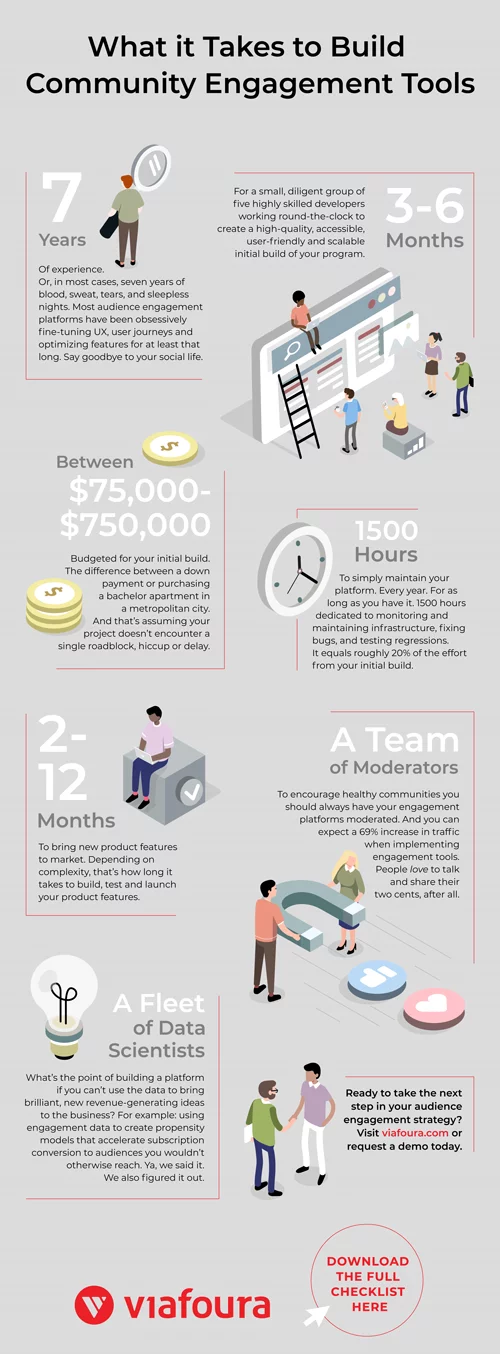When it comes to building a new tool for your digital properties in-house, there’s a lot to get excited about: like customization opportunities and the chance for your developers to put together their next masterful creation. But building a tool from scratch — especially a tool that exists to engage and grow your digital community — isn’t a simple walk in the park… even with the help of open-source code.
The truth is, there’s a whole range of responsibilities that go into building and maintaining a community management tool aside from just integrating free code into your platform. The digital landscape is constantly shifting, which means that whatever is implemented needs to be adjusted every so often to respond to new technical limitations and best practices.
If you’re currently deciding whether to build your own community management tool using open-source code, we’ve broken down exactly what goes into building and maintaining it:
High demand on your technical team
Open-source code is free to use. However, there are plenty of hidden costs that need to be considered.
“It isn’t free if half of your team is working on integrating it,” says Eric Liang, Viafoura’s director of Engineering. “Your team will need to spend time customizing it for your properties, your tech stack, your analytics and ensure a smooth integration. Or, you may want to hire a team to integrate it for you, which means you’ll need the budget for it.”
According to Soltech, a company that creates custom software and support for businesses, “most custom enterprise software projects fall somewhere between the $75,000 and $750,000 mark to design, develop and implement.”
Quality matters. In other words, your community management tool needs to be customized, maintained and optimized for different amounts of web traffic. Before you begin building onto an open-source tool, plan out the amount of time, staff and skill needed for the entire process.
The importance of first-party data
There’s a good reason why it’s important that your tools deliver first-party data to clients. The more data you have from your platform’s visitors, the more you’ll come to understand their behaviors and the types of content they like to consume.
In addition, Deloitte found that “the best-in-class companies successfully use audience data to drive revenue, and record market-leading financial performance.”
One of the perks to using a software as a service (SaaS) solution is that many of them use APIs – tools for building and integrating software components – to give you access to your first-party data in a secure way. This data can then be analyzed to determine how users are interacting with your brand, content and other users.
If you’re planning to take on an open-source community engagement tool, you’re going to need a way to access that data. You may want to implement several open-source tools or build a custom solution to do so and then figure out where to store the data.
Ultimately, any knowledge you can get about your brand’s community is power, especially in the digital world.
An article from MediaPost even states that “91% of people are more likely to shop with brands providing them with relevant recommendations and experiences.”
Are you ready to put thousands of hours into support?
In order to host a new tool on your domain, and maintain positive user experience, there must be a plan in place for regular updates and support.
“We have highly skilled team members monitoring and maintaining infrastructure, fixing bugs, working with customers, and testing regressions between 5000 and 6000 hours a year,” Liang explains. “By providing round-the-clock support for our customers, their communities cannot be overlooked.”
While it may not be feasible to sacrifice so much of your team and company’s time to support your own tool, be sure to have preventative measures in place to deal with bugs and respond to customers. Without long-term support, you could be left with frustrated users who feel abandoned by your company if your system ever breaks.
Moderation is a must
As soon as you open your digital properties to commenting and live chat or blogging tools, you’re going to have to mitigate a few major obstacles: spam, political influencers, trolls and any other type of toxic comments.
It’s important to keep social interactions as civil as possible. That way, you can provide a safe environment for visitors to engage with on your domains. Whether you decide to use a third-party moderator or task your own team with monitoring the flood of daily comments is up to you.
Consider investing in intelligent moderation services to save your business time and focus on what you truly excel at: building out great content.
A backup plan is always required
When you rely on free tools or plugins to manage your community, it’s worth making sure you have a backup plan… just in case it ever fails.
According to reports earlier this year, even Facebook’s popular commenting plugin failed iOS users.
It just goes to show that if you’re building out a community management tool, there’s no such thing as a quality shortcut. Although open-source tools are helpful to a certain extent, putting in that short-term and long-term legwork is essential to its success.



